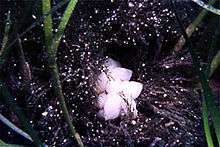Phallusia mammillata
| Phallusia mammillata | |
|---|---|
 | |
| Scientific classification | |
| Kingdom: | Animalia |
| Phylum: | Chordata |
| Subphylum: | Tunicata |
| Class: | Ascidiacea |
| Order: | Enterogona |
| Family: | Ascidiidae |
| Genus: | Phallusia |
| Species: | P. mammillata |
| Binomial name | |
| Phallusia mammillata (Cuvier, 1815)[1] | |
| Synonyms[1] | |
| |
Phallusia mammillata is a solitary marine tunicate of the ascidian class found in the eastern Atlantic Ocean and the Mediterranean Sea.
Description
Phallusia mammillata is a solitary species of ascidian and can grow to a height of about 20 cm (8 in). The tunic is a translucent, bluish-white colour and is covered with irregular rounded lobes or mounds.[2]
Distribution
This tunicate is found on rocky, sandy or muddy substrates in the northeastern Atlantic Ocean, the North Sea, the English Channel and the Mediterranean Sea to depths of about 200 m (656 ft).[2]
Biology
Like all tunicates, Phallusia mammillata has a thick leathery tunic containing a cellulosic material. The tunic encloses a sac-shaped cavity with separate siphons through which water is drawn in and expelled. The animal feeds on the planktonic particles that it filters from the incoming seawater by passing it through a mucous net.[3]
P. mammillata is one of a small number of ascidians that accumulate the element vanadium in their blood cells.[4] It is unclear why the tunicate should do this, but concentrations of up to 350 mM have been found, some ten million times higher than in the surrounding seawater. The ascidian has at least ten different types of blood cell, and the vanadium-accumulating cells have been shown to be "vacuolated and granular amoebocytes, signet ring cells and type-II compartment cells".[4]
Each P. mammillata individual is a hermaphrodite. Eggs are released through the exhalent siphon and external fertilization in the water column takes place. The eggs hatch into free-swimming, tadpole-like larvae, which within a few days settle on the seabed and undergo metamorphosis into juveniles.[5]
References
- 1 2 Sanamyan, K. (2016). Noa Shenkar, Arjan Gittenberger, Gretchen Lambert, Marc Rius, Rosana Moreira Da Rocha, Billie J Swalla & Xavier Turon, eds. "Phallusia mammillata (Cuvier, 1815)". Ascidiacea World Database. World Register of Marine Species. Retrieved 13 May 2016.
- 1 2 "Ascidie blanche: Phallusia mamillata: (Cuvier, 1815)". DORIS. Retrieved 13 May 2016.
- ↑ Ruppert, Edward E.; Fox, Richard, S.; Barnes, Robert D. (2004). Invertebrate Zoology, 7th edition. Cengage Learning. p. 940. ISBN 978-81-315-0104-7.
- 1 2 Tatsuya Ueki; Kuniko Takemot; Barbara Fayard; Murielle Salomé; Akitsugu Yamamoto; Hiroshi Kihara; Jean Susini; Silvia Scippa; Taro Uyama; Hitoshi Michibata (2002). "Scanning X-ray Microscopy of Living and Freeze-Dried Blood Cells in Two Vanadium-Rich Ascidian Species, Phallusia mammillata and Ascidia sydneiensis samea". Zoological Science. 19 (1): 27–35. doi:10.2108/zsj.19.27.
- ↑ Berrill, N.J. (1930). "Studies in Tunicate Development. Part I. General Physiology of Development of Simple Ascidians". Philosophical Transactions of the Royal Society of London. Series B,. 218: 73. JSTOR 92217.